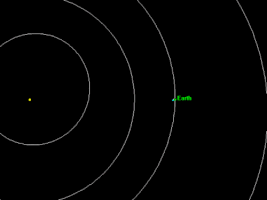
J002E3 is an object in space which is thought to be the S-IVB third stage of the Apollo 12 Saturn V rocket. It was discovered on September 3, 2002, by amateur astronomer Bill Yeung. Initially thought to be an asteroid, it has since been tentatively identified as the third stage of Apollo 12 Saturn V based on spectrographic evidence consistent with the titanium dioxide in the paint used on the rockets.[1][2][3] The stage was intended to be injected into a permanent heliocentric orbit in November 1969, but is now believed instead to have gone into an unstable high Earth orbit which left Earth's proximity in 1971 and again in June 2003, with an approximately 40-year cycle between heliocentric and geocentric orbit.[4]
- ^ Chodas, Paul; Chesley, Steve (11 October 2002). "J002E3: An Update". SpaceRef. NASA. Retrieved 25 August 2023.
- ^ Jorgensen, K.; Rivkin, A.; Binzel, R.; Whitely, R.; Hergenrother, C.; Chodas, P.; Chesley, S.; Vilas, F. (May 2003). "Observations of J002E3: Possible Discovery of an Apollo Rocket Body". Bulletin of the American Astronomical Society. 35: 981. Bibcode:2003DPS....35.3602J.
Through the modeling of common spacecraft materials, the observations of J002E3 show a strong correlation of absorption features to a combination of human-made materials including white paint, black paint, and aluminum. Absorption features in the near IR show a strong correlation with paint containing a titanium-oxide semiconductor. Using the material model and the orbital information, it was concluded that J002E3 is a human-made object from an Apollo rocket upperstage, most likely Apollo 12.
- ^ "First Confirmed Capture into Earth Orbit Is Likely Apollo Rocket". Jet Propulsion Laboratory. NASA. 20 September 2002. Archived from the original on 25 August 2023. Retrieved 25 August 2023.
- ^ Chodas, Paul (11 September 2002). "Newly Discovered Object Could be a Leftover Apollo Rocket Stage". Center for Near Eath Object Studies. NASA. Archived from the original on 3 September 2018. Retrieved 25 August 2023.

